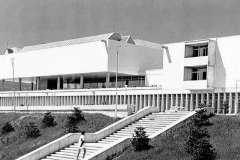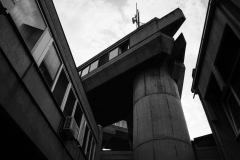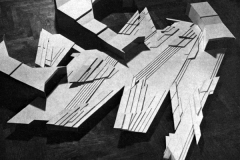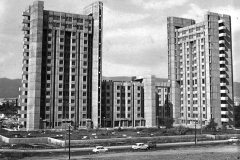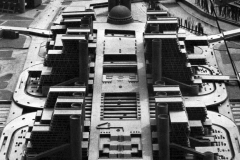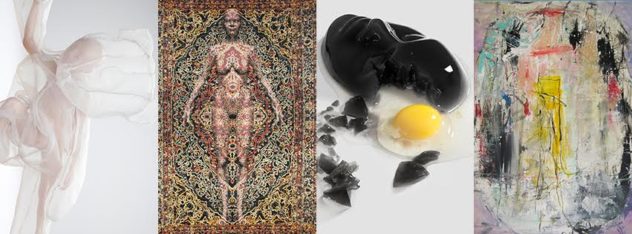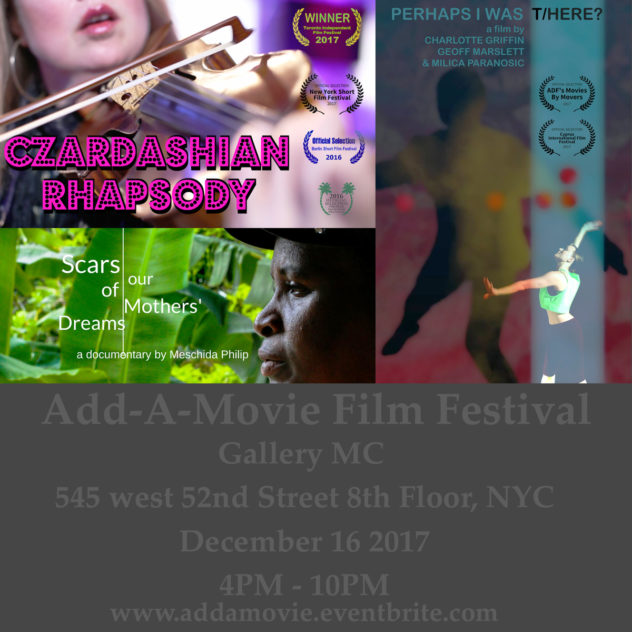“Constructing a Modernist Utopia: The Architecture of The Post-Earthquake Renewal of Skopje, 1963-1981”
Exhibition and Gallery Talk Organized by Museum of Contemporary Art in Skopje, Macedonia:
Modernism Disregarded; Towards The Aesthetics of Populism
The rapid pace of development of Skopje was interrupted by the catastrophic earthquake that stroke Skopje on July 26th 1963 and demolished almost 80% of the urban tissue, leaving the city literally reduced to rubble. The aftermath of the earthquake propelled unprecedented international solidarity, while the post-earthquake renewal of the city brought up the undoubtedly most powerful segment within its recent architectural history. The extensive expressions of help coming from more than 80 countries worldwide were unique in their scope and the value connected to them. Under the auspices of the UN, formerly local and peripheral city of Skopje transformed into a field of global cooperation and a late-modern urban laboratory for testing the latest urban and architectural paradigms.
Inseparably connected with the prospering and decline of Yugoslavia, this (relatively) recent architectural legacy (at times simply unjustifiably labeled as “socialist”) can be evaluated as well as criticized in the same terms as most of the modernist architecture. Built rapidly and above all pragmatically, its execution often slowed down by the economic or technical limits, it intrinsically carries the long term aim to reach the utopian horizon for a better future, addressed to all segments of the society.
During the last two decades, the city underwent yet another great change. After the collapse of the socialism and the violent dissolution of Yugoslavia, the Republic of Macedonia and Skopje as its capital entered the extended and highly uncertain process of transition from socialism towards liberal capitalism. Advancing it political status from a republic to a national capital (capital city of an independent and sovereign country), Skopje entered a process of dramatic remodeling not unlike other cities in Central and Eastern Europe.
This social and cultural re-“traditionalisation” pushed to their limits, within the field of architecture resulted in erection of new “neo”-eclectic buildings (mostly governmental institutions), vast amount of highly narrative historical monuments, as well as strong effort to banish the modern heritage and values from the public memory and erase them accordingly.
Along with the challenges linked to the political, economic, social and cultural life, this political process launched a dynamic and dramatic spatial transformation, especially within the past 10 years and due to the emergence of the “Project Skopje 2014”. Strongly political and highly controversial in its nature, it exploited a strong “historical” narrative to shift the focus towards a “quasi” national quest for identity, transforming Skopje into a “national” capital.
Lecturer: Vladimir Deskov is an architect born in Skopje in 1977. Since 2007 he works as a lecturer at the School of Architecture and Design, University American College Skopje. His research interest focuses on the city of Skopje and its architecture, as well as the influence of economic, political and social transformations of society on the way in which the city changes, and their impact on architecture.
His specific interest is the transformation of the city of Skopje as a result of the recent quasi-historical populist interventions of the project “Skopje 2014”. Strongly political and highly controversial in its nature, the “Skopje 2014” project exploited a strong “historical” narrative to shift the focus towards a “quasi” national quest for identity, transforming Skopje into a “national” capital while Skopje’s modernist heritage disappears under the layers of styrofoam and faux historical facades. During the realization of the “Skopje 2014” project he worked actively on research, exhibitions and publications which reaffirmed endangered Skopje modernist heritage.
In 2014, Deskov was one of the authors representing Macedonia at the 14. Venice Biennale of Architecture with the project “Findings”.
Since 2015 he is a member of the curatorial advisory board of The Museum of Modern Art forthcoming exhibition – “Toward a Concrete Utopia: Architecture in Yugoslavia, 1948–1980” the first major exhibition in the United States to examine the modernist architecture of the region.
In 2017 he was one of the curators of the exhibition “Skopje – Architecture in the Macedonian context”.

